
| U2 Ruhleben - Pankow | ||||
| UrbanRail.Net > Europe > Berlin | ||||
|
|
||||
|
Small-profile line with ~105 m long platforms (8-car trains of A3 and GII stock, or double 4-car trainsets of HK stock in service). At the western end of line U2, every other train terminates at Theodor-Heuss-Platz during daytime service. From Ruhleben, line U2 runs on an embankment to Olympia-Stadion, past the main workshops for the small-profile rolling stock. Just after Olympia-Stadion station, trains enter the first tunnel section, which runs through the district of Charlottenburg to a point between Wittenbergplatz and Nollendorfplatz. The section between Ernst-Reuter-Platz (formerly Knie) and Potsdamer Platz is part of the original U-Bahn opened in 1902. From 1906 until 1970, there was a branch from Deutsche Oper to Wilhelmplatz (now Richard-Wagner-Platz), a section later replaced by the present line U7. The next underground section starts right after Mendelssohn-Bartholdy-Park, with the ramp completely covered in 2009. The line winds its way through the city centre on a rather indirect route, as Leipziger Straße was the domain of the urban tramway lines. North of the Mitte district, line U2 emerges from the tunnel to continue on an elevated structure along Schönhauser Allee in the popular district of Prenzlauer Berg, before re-entering the tunnel between Schönhauser Allee and Vinetastraße stations, the latter remaining the northern terminus from 1930 until 2000, when the line was finally extended to Pankow S-Bahn station. What is now line U2, was split into two separate lines when the Wall was erected in 1961. The elevated section between Nollendorfplatz and Gleisdreieck was out of service from 1972 until 1993. The section between Nollendorfplatz and Bülowstraße, however, was operated by a vintage tram for some years. The lower level at Gleisdreieck was occupied by the trial service of the 'M-Bahn', a magnetic levitation system later dismantled to make room for the reconstruction of line U2 across the former borderline. 18-02-1902:
Potsdamer Platz - [Möckernbrücke - Stralauer Thor
U1]
|
||||
|
Alexander Seefeldt: Berliner U-Bahn-Linien: U2 - Die "City-Linie" über Zoo und Alex - Nov. 2017, ISBN 978 3 836573 53 4 |
||||
| |
||||
| Ruhleben |
22-12-1929 stub station on an embankment
|
|
||
| Olympia-Stadion |
08-06-1913 (until 1922 for special events only) at grade; three tracks with two island platform; large entrance building, with U-Bahn Museum located inside former signal box.
|
|
||
| Neu-Westend |
08-06-1913
|
|
||
| Theodor-Heuss-Platz |
|
29-03-1908 terminus for every other train; side platforms
|
|
|
| Kaiserdamm |
29-03-1908 Transfer to S-Bahn station Messe Nord/ICC via street level; side platforms S-Bahn tracks, which are in a cutting, are crossed on a bridge, which is actually the lower level of the road bridge.
|
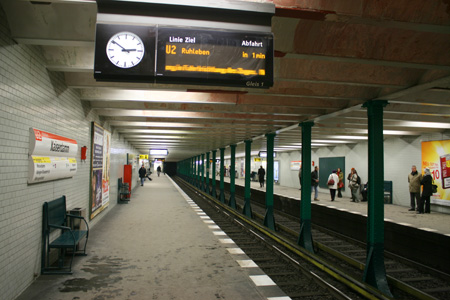 |
||
| Sophie-Charlotte-Platz |
29-03-1908 Rather original design, with walls later covered with images depicting old U-Bahn stations and trains; side platforms.
|
|
||
| Bismarckstraße |
28-04-1978 side platforms; station added to provide direct transfer to line U7 which runs on the lower level.
|
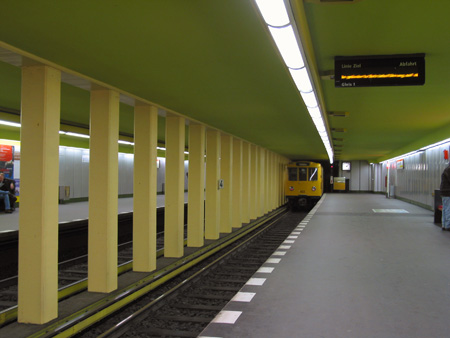 |
||
| Deutsche Oper |
14-05-1906 two island platforms, with line U2 only using the outer tracks; the inner tracks were used by trains going to Wilhelmplatz (Richard-Wagner-Platz). Restored to original design after a fire in 2000.
|
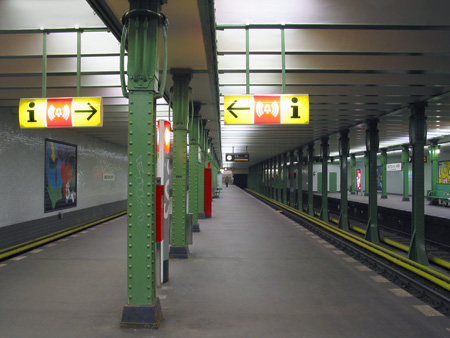 |
||
| Ernst-Reuter-Platz |
14-12-1902 side platforms;
|
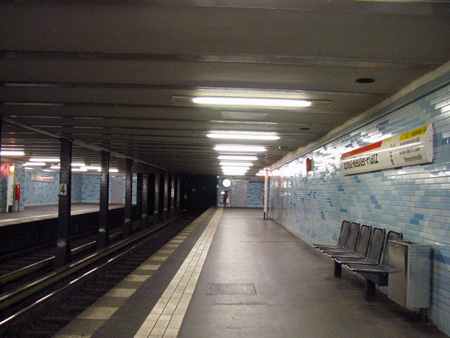 |
||
| Zoologischer Garten |
|
11-03-1902 Slightly rebuilt in the early 1960s to create convenient interchange with line U9. Located in the heart of City West, formerly busy mainline station.
|
|
|
| Wittenbergplatz |
11-03-1902, rebuilt in 1913 initially standard two-track station, but later rebuilt to accommodate the other two western branches, and enhanced with an outstanding entrance building.
|
|
||
| Nollendorfplatz |
11-03-1902 elevated station with side platforms; originally with a dome above the western entrance, which was rebuilt in a simplified form in 2002.
|
|
||
| Bülowstraße |
|
11-03-1902 elevated station with side platforms; mostly preserved in its original style. |
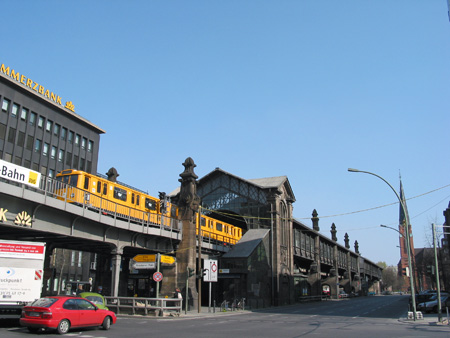 |
|
| Gleisdreieck |
03-12-1912 line U2 stops on the lower level of the 2-level station added on the site of the original triangular junction. |
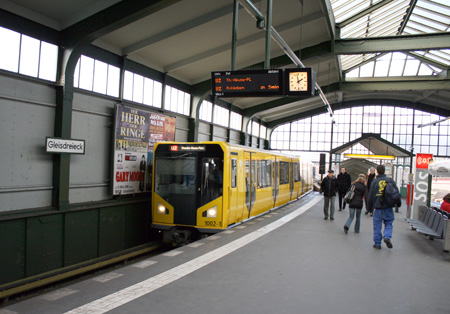 |
||
| Mendelssohn- Bartholdy-Park |
01-10-1998 elevated station with side platforms, added on the existing line to improve access to the Potsdamer Platz area
|
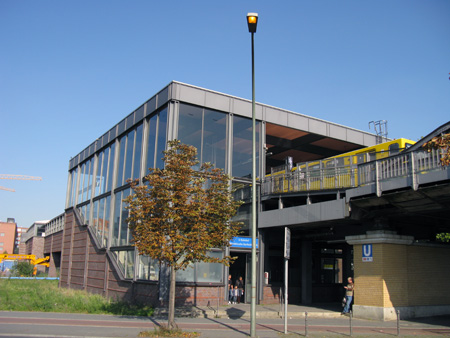 |
||
| Potsdamer Platz |
18-02-1902, rebuilt in 1908 Original station (Berlin's oldest underground station) was demolished to allow for the extension into the city centre. Closed between 1961 and 1993, though used for stabling trains from the eastern side.
|
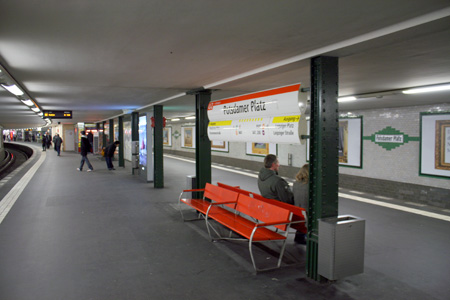 |
||
|
Anton-Wilhelm-Amo-Straße |
01-10-1908 Terminus from 1961 to 1993 of East Berlin's only small-profile line. Until Aug 2025 "Mohrenstraße"
|
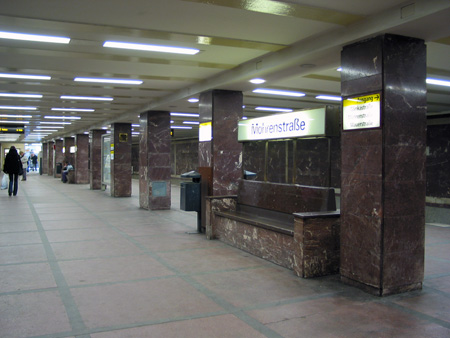 |
||
| Stadtmitte |
01-10-1908 Long and narrow transfer corridor between lines U2 and U6, known as the 'mouse tunnel'.
|
|
||
| Hausvogteiplatz |
01-10-1908 Rather curved island platform
|
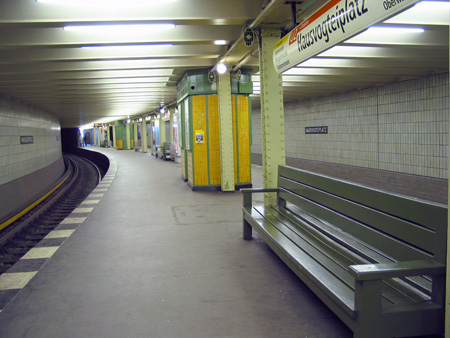 |
||
| Spittelmarkt |
01-10-1908 On the northern side, where the line lies directly side by side with the Spree River, several openings allow daylight into the station.
|
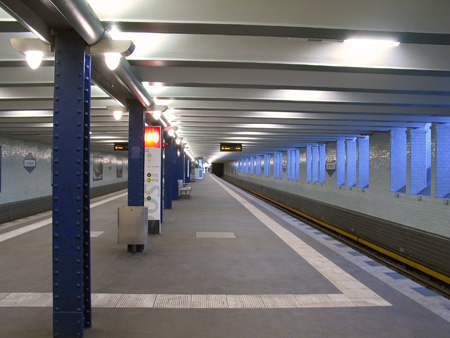 |
||
| Märkisches Museum |
01-07-1913 Due to the following river crossing the station is higher than usual and boasts a Paris-style vaulted ceiling without supporting pillars.
|
|
||
| Klosterstraße |
01-07-1913 Originally laid out with three tracks in a provision for an eastern branch line, the island platform is unusually wide; converted into a kind of museum in 1987 with images illustrating historical transport vehicles, from buses to S-Bahn trains. At the northern end, an original carriage from the Schöneberg U-Bahn (now U4) is on display.
|
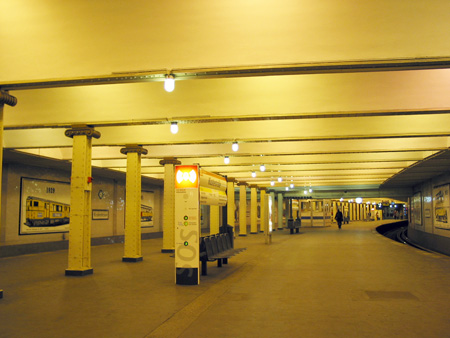 |
||
| Alexanderplatz |
01-07-1913 Eastern stroke of the H-shaped Alexanderplatz complex, including lines U5 and U8. |
|
||
| Rosa-Luxemburg-Platz |
27-07-1913
|
 |
||
| Senefelderplatz |
27-07-1913
|
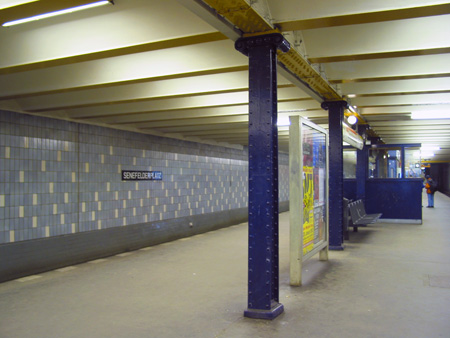 |
||
| Eberswalder Straße |
27-07-1913 elevated station
|
|
||
| Schönhauser Allee |
27-07-1913 elevated station, whereas the S-Bahn is below ground level |
|
||
| Vinetastraße |
29-06-1930
|
|
||
| Pankow |
16-09-2000
|
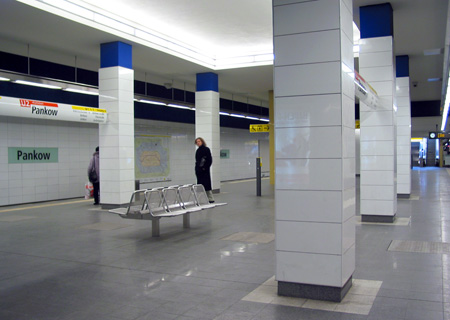 |
||
2009 © UrbanRail.Net (Robert Schwandl)